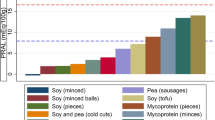Abstract
Excretion of malondialdehyde (MDA)-generating substances in the urine has been suggested as an indicator ofin vivo lipid peroxidation. However, MDA in the urine also reflects the amount of lipid peroxidation products consumed in the diet. We determined MDA as the thiobarbituric acid (TBA)-MDA complex in urine of 19 healthy adults (10 male and 9 female) fed large quantities (3.6–4.1 g/kg body weight) of ground beef cooked at a low or a high temperature. Subjects are a controlled diet with no alcohol or nutritional supplements. For 7 d they consumed ground beef cooked at 100°C for 20 min (low-temperature meat) followed by 7 d with meat fried at 250°C for 22 min (high-temperature meat). Prior to the study, subjects consumed their normal free choice diet with moderate amounts of meat. The concentration of MDA in urine at baseline was 2.1±0.3 μmol TBA-MDA equivalents/day (mean±SEM). After 7 d of low-temperature meat, urinary TBA-MDA equivalents increased to 23.1±1.4 μmol/d. Urinary TBA-MDA equivalents were consistently lower (6.9–8.0 μmol/d) 1, 2, 3, and 7 d after subjects changed to high-temperature meat. After 7 d of treatment, 97% of the MDA-equivalents in the meat was recovered in 24-h urine samples. The low temperature meat had 3–4 times more MDA than did the high-temperature meat. These data indicate that the amount of meat eaten and the cooking procedures used can dramatically alter urinary MDA. Dietary sources of MDA must be controlled if urinary MDA is to be used as an indicator of oxidative stress.
Similar content being viewed by others
Abbreviations
- MDA:
-
malondialdehyde
- TBA:
-
thiobarbituric acid
References
Pryor, W.A., and Godber, S.S. (1991) Noninvasive Measures of Oxidative Stress Status in Humans,Free Radic. Biol. Med. 10, 177–184.
Siu, G.M., and Draper, H.H. (1978) A Survey of the Malonaldehyde Content of Retail Meats and Fish.J. Food Sci. 43, 1147–1149.
Newburg, D.S., and Concon, J.M. (1980) Malonaldehyde Concentrations in Food Are Affected by Cooking Conditions,J. Food Sci. 45, 1681–1687.
Jacobson, E.A., Newmark, H.L., Bird, R.P., and Bruce, W.R. (1983) Increased Excretion of Malonaldehyde Equivalents in the Urine After Consumption of Cooked, Stored Meats,Nutr. Rep. Intl. 28, 509–517.
Nelson, G.J., Morris, V.C., Schmidt, P.C., and Levander, O. (1993) The Urinary Excretion of Thiobarbituric Acid Reactive Substances and Malondialdehyde by Normal Adult Males After Consuming a Diet Containing Salmon,Lipids 28, 757–761.
Slater, T.F., Cheeseman, K.H., Davies, M.J., Proudfoot, K., and Xin, W. (1987) Free Radical Mechanisms in Relation to Tissue Injury,Proc. Nutr. Soc. 49, 1–12.
Basu, A.K., and Marnett, L.J. (1983) Unequivocal Demonstration That Malondialdehyde Is a Mutagen,Carcinogenesis 4, 331–333.
Shamberger, R.J., Andreone, T.L., and Willis, C.E. (1974) Antioxidants and Cancer. IV. Initiating Activity of Malonaldehyde as a Carcinogen.J. Natl Cancer Inst. 53, 1771–1773.
Chaudhary, A.K., Nokubo, M., Reddy, G.R., Yeola, S.N., Morrow, J.D., Blair, I.A., and Marnett, L.J. (1994) Detection of Endogenous Malondialdehyde-Deoxyguanosine Adducts in Human Liver,Science 265, 1580–1582.
Draper, H.H., and Hadley, M. (1990) A Review of Recent Studies on the Metabolism of Exogenous and Endogenous Malondialdehyde,Xenobiotica 20, 901–907.
Halliwell, B., and Chirico, S. (1993) Lipid Peroxidation: Its Mechanism, Measurement, and Significance,Am. J. Clin. Nutr. 57, 715S-725S.
Draper, H.H., Squires, E.J., Mahmoodi, H., Wu, J., Agarwal, S., and Hadley, M. (1993) A Comparative Evaluation of Thiobarbituric Acid Methods for the Determination of Malondialdehyde in Biological Materials,Free Radic. Biol. Med. 15, 353–363.
Piche, L.A., Cole, P.D., Hadley, M., van den Bergh, R., and Draper, H.H. (1988) Identification of N-ε-(2-propernal)lysine as the Main Form of Malondialdehyde in Food Digesta,Carcinogenesis 9, 473–477.
Ames, B.N., McCann, J., and Yamasaki, E. (1975), Methods for Detecting Carcinogens and Mutagens with the Salmonella/Mamalian-Microsomal Mutagenicity Test,Mutat. Res. 31, 347–364.
Furihata, C., and Matsushima, T. (1986) Mutagens and Carcinogens in Foods,Ann. Rev. Nutr. 6, 67–94.
Dhanakoti, S.N., and Draper, H.H. (1987) Response of Urinary Malondialdehyde to Factors That Stimulate Lipid Peroxidationin Vivo, Lipids 22, 643–646.
Lee, H.S., Shoeman, D.W., and Csallany, A.S. (1992) Urinary Response toin vivo Lipid Peroxidation Induced by Vitamin E Deficiency,Lipids 27, 124–128.
Baird, M.B., Hough, J.L., and Sfeir, G.T. (1993) Accumulation of Malondialdehyde in Mouse Heart Following Acute Dosing with Adriamycin Is Strain-Specific and Unaffected by Cardiac Catalase Status,Res. Commun. Chem. Pathol. Pharmacol. 80, 363–366.
Bagchi, D., Bagchi, M., Hasoun, E., and Stohs, S.J. (1993) Carbon-Tetrachloride-Induced Urinary Excretion of Formaldehyde, Malondialdehyde, Acetaldehyde and Acetone in Rats,Pharmacology 47, 209–216.
Gallaher, D.D., Csallany, A.S., Shoeman, D.W., and Olson, J.M. (1993) Diabetes Increases Excretion of Urinary Malonaldehyde Conjugates in Rats,Lipids 28, 663–666.
Author information
Authors and Affiliations
About this article
Cite this article
Brown, E.D., Morris, V.C., Rhodes, D.G. et al. Urinary Malondialdehyde-Equivalents during ingestion of meat cooked at high or low temperatures. Lipids 30, 1053–1056 (1995). https://doi.org/10.1007/BF02536291
Revised:
Accepted:
Issue Date:
DOI: https://doi.org/10.1007/BF02536291




